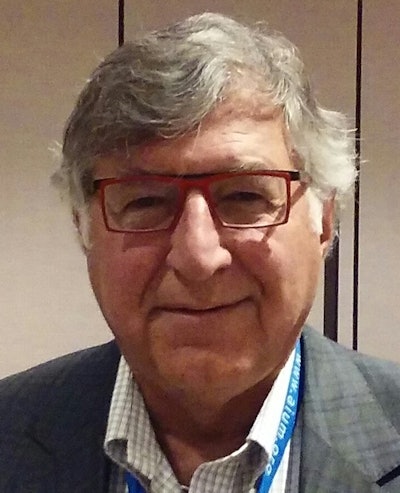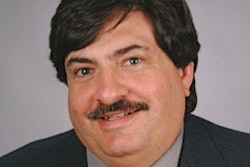
NEW YORK CITY - As artificial intelligence (AI), computer-aided detection (CAD), and pattern recognition become even more of a reality in healthcare, radiologists must leave the comfort of the reading room and reclaim their role as consultants for their clinician peers, according to a Sunday presentation at the American Institute of Ultrasound in Medicine (AIUM) meeting.
"Without this change, radiologists risk being replaced by technology," Dr. Edward Lyons of the University of Manitoba in Winnipeg told session attendees. "We have to evolve from a role based solely on productivity and become more accessible to survive."
Problem solvers
For radiology's first 100 years, radiologists acted as problem solvers for their fellow physicians, Lyons said.
 Dr. Edward Lyons from the University of Manitoba.
Dr. Edward Lyons from the University of Manitoba."When we had film, the radiologist ruled, because everything focused around the reading room," he said. "The reading room was a hub of activity, and the clinical team always came for advice. Each medical service had an assigned radiologist or resident who reviewed each patient and made recommendations for follow-up based on current images, acting as a real consultant."
But with the advent of PACS in the mid-1990s, radiology became increasingly digitized, and images were available to everyone from anywhere in the hospital. This shift made radiologists less accessible to their physician peers, weakening their consultation role while at the same time increasing their workloads, according to Lyons.
This trend has the potential to be dangerous for radiology, as medicine continues to incorporate artificial intelligence and machine learning into its protocols.
"The radiologist now has a dilemma: productivity versus accessibility," he said. "If you want to earn as much as you can, you sit in the reading room and grind out as many films as possible. You become a machine. But that comes at the cost of accessibility -- that is, less and less radiology consultation. So what will radiologists do when -- not if -- computers start to read cases faster and better?"
AI predictions
Web-based AI and CAD will be reading all x-rays, CT scans, and MRI studies within five to 10 years, Lyons predicted. In fact, the future may already be here: A 2017 study found that a computer program for diagnosing wrist, hand, and ankle fractures was 83% accurate after learning from a sample of more than 250,000 x-rays (Acta Orthopedica, July 6, 2017). He also cited Aidoc, an Israeli start-up that has developed a machine-learning tool to train computers to rapidly identify CT and MRI abnormalities and produce a report.
"When I tell my radiology colleagues this is coming, they say I'm crazy, that it won't happen in their lifetimes," Lyons said. "But we see there are plenty of attempts at computerizing radiology already. Someone like Elon Musk, with tons of money, tons of computer specialists, could make it happen, in order to have access to healthcare data."
So how might AI actually influence the radiologist's role in coming years? Lyons described two scenarios:
- The radiologist becomes a key part of the healthcare team by making diagnoses sooner and with greater accuracy using AI tools.
- The radiologist is replaced by AI as computers interpret and report cases directly to the ordering physician.
"There are two options," Lyons said. "Radiologists will become an integral member of the healthcare team, making diagnoses with greater accuracy, and will discuss the results with the clinicians relative to particular patients. On the other hand, if radiologists don't heed the call, they will ultimately be replaced -- or certainly paid less for what they're doing. The computers will interpret and report cases directly to the clinician."
Lyons acknowledged that the latter scenario could be complicated by regulatory and legal issues.
"The computer is doing everything, but will the [U.S. Food and Drug Administration] approve that? Will Health Canada approve it? And what about medicolegal issues?" he said. "So yes, maybe the computer does the screening for abnormal results and radiologist does the interpretation. But the question remains: What will radiology's role be as computers increasingly interpret the images?"
Part of the team
Lyons offered a suggestion for making sure radiologists stay part of the healthcare team: Put some radiologists in the hospital's clinical areas so they can act as a consultant to physician staff and lead the way in recommending and facilitating new studies.
"The bottom line is, put some radiologists near the patients -- in the intensive care unit, in the emergency room -- so they are an integral member of healthcare team," he said. "It will mean less productivity but more accessibility."




















